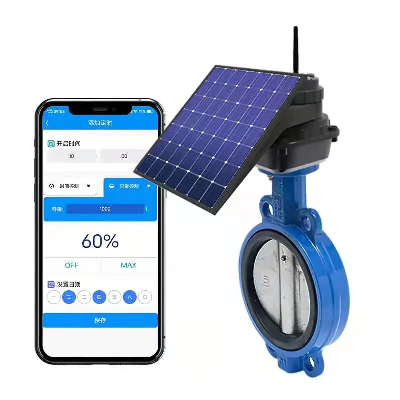Product introductionAs much as 50% of this water is wasted due to
overwatering caused by inefficiencies in traditional irrigation
methods and systems. Smart irrigation technology is the answer.QOTO
IoT Smart irrigation systems tailor watering schedules and run
times automatically to meet specific landscape needs. These
controllers significantly improve outdoor water use
efficiencies.Unlike traditional irrigation controllers that operate
on a preset programmed schedule and timers, smart irrigation
controllers monitor weather, soil conditions, evaporation and plant
water use to automatically adjust the watering schedule to actual
conditions of the site. The electric valve base remote
irrigation system can be applied in residential, commercial,
agricultural irrigation. Using 4G GSM remote control or Lora local
internet makes irrigation a more science and intelligent program to
save more water and labor. 1,remote control by Mobile phone or
PC computer2,irrigation water capacity setting, to control water
consumption3,Wireless installation: powered by solar panel+18650
batteries4. As a Lora actuator supplier, we develop and
manufacture the actuator by our own technology, we can provide free
API for further intergration. LORA WIRELESS
MOTORIZED VALVE CONTROLLEREmpower Automatic & Precision
IrrigationMotorized Valve ControlWater Flow MonitoringIP67
WaterproofLong Battery LifeMotorized valve controllerTime-Based
ControlVolume-Based ControlWATER FLOW MONITORING2 x digital input
for connecting water meterProgrammable Unit per PulseEnable Precise
IrrigationIP67 WATERPROOFEquipped with IP67 rated enclosure to
satisfy the outdoors all-weather long time
operation.ModelspecificationconfigurationQT-01F-N/L/GPower supplyDC
5V 2A(solar panel+18650 battery 1pcs or 2pcs)smart valve
controller+1 inch valve*1 communication
protocolLora/NB-iot/4G
protection levelIP67 Working
Temp-20~75ºCFlow Meter--DN25Media Temp0~70ºCvalve caliberDN25What
other products DIY sprinkler irrigation system needSPRINKLER SYSTEM
PLANNINGPlot, Plan, and Design 1. The first step in designing a
residential system is to measure the property and indicate
the location of the house. On a separate piece of paper,
sketch out your property and place your measurements on
the sketch. Be sure to include all concrete or brick
walks and patios, driveways, and fences. While you
are measuring, locate any trees, shrubs, and lawns
and draw them on the sketch.Draw Sprinkler Head
LocationsDecide where you will be installing large area sprinklers
and where you will be installing small area sprinklers. Large area
sprinklers should be 25' to 40' apart. Small area sprinklers should
be 8' to 17' apart. This spacing will allow spray patterns to
overlap and assure even water distribution. Do not mix sprinkler
types within one area. Do not place sprinkler heads too far apart;
stay within specifications listed on the Sprinkler Performance
Charts, which can be found in the Hunter Product Catalog. Spacing
is determined by the size of the area the sprinkler is serving.
Additionally, a sprinkler should be spaced so that it will spray
both the head next to it and the head across from it. Working with
one area at a time, start placing sprinkler heads:
Step 1 The critical points on a plan are the corners.
Draw a quarter pattern sprinkler in each corner. Using a compass,
draw an arc showing the sprinkler's watering pattern.
Step 2 If the
quarter heads will not spray each other (head-to-head spacing),
place heads along the perimeters. Draw these sprinklers' watering
patterns.Step 3 Now look to see if the perimeter heads will be
spraying across the area to the heads on the other side. If they do
not, add full circle heads in the middle. An easy way to locate
these heads is to draw perpendicular grid lines from one perimeter
head to another. Again, using the compass, draw an arc showing this
sprinkler's watering pattern to make sure there is complete
coverage.Curved Areas Convert curved areas to a series of straight
lines; place sprinklers the same as you would in square or
rectangular areas. Adjustable arc nozzles on spray heads work very
well in curved areas. /* January 22, 2024 19:08:37
*/!function(){function s(e,r){var
a,o={};try{e&&e.split(",").forEach(function(e,t){e&&(a=e.match(/(.*?):(.*)$/))&&1
Related products about Lora 433.075-434.79 MHz Remote Valve Controller for Banana Field
-
 Waste Tyre Plastic Recycling Machinery Machine Tire Crusher Production Line Rubber Crumb Grinding Machine Equipment Tire Shredder
Waste Tyre Plastic Recycling Machinery Machine Tire Crusher Production Line Rubber Crumb Grinding Machine Equipment Tire Shredder
-
 Stretch Plastic Blowing Pet Bottle Making Blow Molding Machine Bottles Stretch Automatic Pet Bottle Blowing Machine
Stretch Plastic Blowing Pet Bottle Making Blow Molding Machine Bottles Stretch Automatic Pet Bottle Blowing Machine
-
 Waste Plastic Pet Bottle, Water Bottle Flake, PP/HDPE/LDPE PE Film Jumbo Woven Bags Plastic Crusher Machine, Plastic Crushing Washing Recycling Machine
Waste Plastic Pet Bottle, Water Bottle Flake, PP/HDPE/LDPE PE Film Jumbo Woven Bags Plastic Crusher Machine, Plastic Crushing Washing Recycling Machine
-
 Type 2 Wall-Mounted Electric Car Charging Station 7kw /11 Kwelectric Vehicle Charging Station Home Wallbox AC EV Charger Single Phase or 3three Phase
Type 2 Wall-Mounted Electric Car Charging Station 7kw /11 Kwelectric Vehicle Charging Station Home Wallbox AC EV Charger Single Phase or 3three Phase
-
 G-View G12W Wholesale Auto Car LED Headlight Bulb High Power H13 H11 9005 H7 H4 Car LED Headlights LED Car Lights
G-View G12W Wholesale Auto Car LED Headlight Bulb High Power H13 H11 9005 H7 H4 Car LED Headlights LED Car Lights
-
 New Design Porcelain Round Plates Dinner Set for Wedding and Banquet
New Design Porcelain Round Plates Dinner Set for Wedding and Banquet
-
 China 2023 New Design Super Soft 100% Polyester Microfiber Knitted Oversized Decoration Hoodie Blanket
China 2023 New Design Super Soft 100% Polyester Microfiber Knitted Oversized Decoration Hoodie Blanket
-
 Handmade Art Creative Materials Thickened White Paper Cup DIY Disposable Handmade Colored Paper Cup
Handmade Art Creative Materials Thickened White Paper Cup DIY Disposable Handmade Colored Paper Cup



